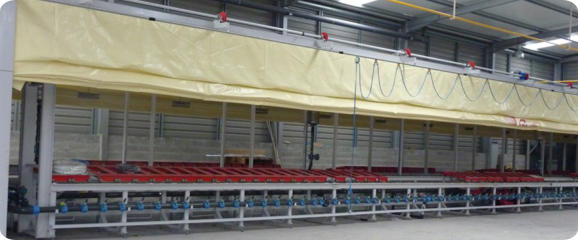
Dryer on Machines
The dryer always consists of:
General support structure in metal
Two terminal sides (orthogonal to the axis of the machine) and fixed roof, made with metal/polyurethane panels, thermally insulating
Sides parallel to the machines made with electrically rolled awnings on motor-rollers, made of double-coated heat-resistant and anti-aging PVC
Indirect flame heat generator, complete with double inlet fan(s) with high efficiency forward blades, combustion chamber and fume/air exchanger in stainless steel, blown air burner and standard ramp
Pipes (movable, in some cases, so as not to disturb the operator) for the distribution of hot air with appropriately positioned nozzles
Pipes and fans for the extraction and recirculation of humid air
System of dampers with electric or pneumatic controls to manage the air flows, directing them as the operating program requires
Internal ventilation units (always provided for vases and boxes, optional for other figures) to facilitate the ventilation of particular mold parts, which are difficult to reach from the general air flow

Fixed Pot Machine
The machine is made by coupling bi-facial modules from 32+32 to 40+40 places.
The coupling can take place indifferently in length or width. If you plan to apply a dryer, it is advisable to create a battery of machines coupled in length.
The molds are closed horizontally and vertically by tie rods
Hydraulically tiltable mold support benches
Lower frame system for supporting the molds on the lower bench. Demoulder for rim pistons with manual movement facilitated by counterweights
Automatic part demoulder with electric motors driven by inverter and pneumatic actuators (LEM)
Allows the extraction and rotation of the mould, the opening of the foot and the decoupling of the lateral half-moulds. Casting system with PVC pipes, supply and distribution valves, stainless steel level trays and accessories for use (taps , probes etc.)
Emptying system with side channel blowers and adjustable overpressure valve.
Electrical system with control panel, protection and casting cycle control.

Demoulder trolley
Our demoulding trolley allows the demoulding of the pieces perpendicular to the bench in particular
- Longitudinal movement at the bench
- Rotation with axis parallel to the bench
- Opening jaws

Inclined Vase Machine
The machine is made by coupling bi-facial modules from 32+32 to 40+40 places.
The coupling can take place indifferently in length or width. If you plan to apply a dryer, it is advisable to create a battery of machines coupled in length.
The molds are closed horizontally and vertically by tie rods
Hydraulically tiltable mold support benches
Lower frame system for supporting the molds on the lower bench. Demoulder for rim pistons with manual movement facilitated by counterweights
Automatic part demoulder with electric motors driven by inverter and pneumatic actuators (LEM)
Allows the extraction and rotation of the mould, the opening of the foot and the decoupling of the lateral half-moulds. Casting system with PVC pipes, supply and distribution valves, stainless steel level trays and accessories for use (taps , probes etc.)
Emptying system with side channel blowers and adjustable overpressure valve.
Electrical system with control panel, protection and casting cycle control.